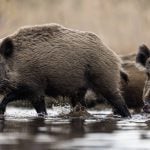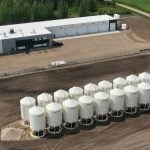While it may seem early to think about next year’s calf crop, preg-checking season is an ideal time to step back and reassess your cow herd’s nutrition. Calves undergo critical development in the first trimester of gestation, forming major organs, skeletal structure and immune systems. Micronutrients, such as trace minerals and vitamins, play a vital role in supporting these processes, yet their supplementation is often overlooked in beef operations. Many producers assume that green pastures meet all of a cow’s nutritional needs. However, most forages are deficient in at least one key micronutrient, making supplementation essential.
Cows experiencing mineral deficiencies during gestation are more likely to produce weak calves, which can lead to more health interventions and long-term performance challenges. These outcomes stem from fetal programming, a process by which the dam’s nutritional status affects the calf’s immune function, growth, carcass yield and quality, and future reproductive success. The challenge is that mineral deficiencies are hard to detect until calves hit the ground, at which point, it’s too late to correct the issue.
Let’s take a closer look at three critical minerals that are frequently deficient in Canadian herds, and why they matter.
Read Also

Promoting Canadian beef in Korea
Canada Beef reports on recent activities, including working with an influencer and an executive chef from Korea
Copper
Copper plays a key role in developing the immune system by supporting the production of enzymes, antibodies and red blood cells. It also contributes to skeletal and nervous system development in the first trimester. When copper levels are adequate, calves are born with a strong frame and robust immunity. In contrast, copper deficiency may result in poor growth, higher illness rates, and, in severe cases, bone abnormalities and anemia. Many areas in Western Canada are naturally copper-deficient, and copper availability to cows can also be reduced by interactions with other minerals, such as sulphur and molybdenum.
Zinc
Zinc is essential for both immune function and growth. It helps activate enzymes involved in tissue repair and wound healing. Calves born to zinc-deficient cows may have dull, patchy coats and increased susceptibility to disease. Zinc deficiency during gestation can also impair fertility later in life by disrupting development of reproductive tissues and delaying puberty.
Selenium
Selenium is better known among producers due to its link to sudden calf deaths. Rapid muscle growth during gestation causes oxidative stress in muscle cells, and selenium is needed to protect against this damage. Without adequate selenium, calves may develop white muscle disease, a condition marked by white streaks in the muscle caused by calcification. Affected calves may appear stiff, struggle to stand or nurse, and suffer from cardiac damage that can result in sudden death within days of birth.

While selenium deficiency is a serious concern, toxicity can also occur, especially in regions with high soil selenium levels. This underscores the need for balanced and careful supplementation.
Next steps: Testing and tailored plans
Copper, zinc and selenium are just part of the broader micronutrient picture. Building better calves starts with regular testing of your feed and water sources. These tests not only help identify deficiencies but can also uncover excess minerals that interfere with absorption or pose toxicity risks. A livestock nutritionist can interpret your test results and help build a targeted supplementation plan based on your farm environment, feed resources and herd needs. Regular monitoring of calf growth and herd health throughout the year will help catch any gaps early.
Bottom line
Mineral supplementation isn’t just about avoiding problems: it’s about unlocking your herd’s full potential. As you head into preg-checking season, take time to review your nutrition program. A small investment in mineral management now can lead to healthier calves, fewer treatments and stronger returns next spring.
Your cows and your bottom line will thank you.
Megan Dubois is a master’s student in ruminant nutrition at the University of Saskatchewan.

















